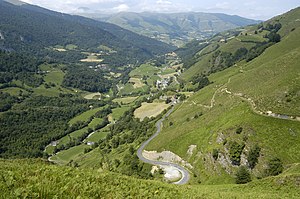Sainte-Engrâce
|
Sainte-Engrâce Santa Grazi |
||
|---|---|---|
|
|
||
| region | Nouvelle-Aquitaine | |
| Department | Pyrénées-Atlantiques | |
| Arrondissement | Oloron-Sainte-Marie | |
| Canton | Montagne Basque | |
| Community association | Pays Basque | |
| Coordinates | 43 ° 1 ′ N , 0 ° 51 ′ W | |
| height | 300-1,881 m | |
| surface | 72.69 km 2 | |
| Residents | 193 (January 1, 2017) | |
| Population density | 3 inhabitants / km 2 | |
| Post Code | 64560 | |
| INSEE code | 64475 | |
 Sainte-Engrâce Church |
||
Sainte-Engrâce ( Basque Santa Grazi or Urdatx ) is a French commune with 193 inhabitants (as of January 1, 2017) in the Pyrénées-Atlantiques department in the Basque part of the Nouvelle-Aquitaine region (before 2016: Aquitaine ). The place and its church bear the name of St. Engratia of Zaragoza .
location
The mountain village of Sainte-Engrâce is about 620 m above sea level in the valley of the river Gave de Sainte-Engrâce ( called Uhaytza in the upper reaches ), about 16 km (driving distance) in a southerly direction from the canton capital Tardets-Sorholus ; the capital of the former province of Soule - Mauléon-Licharre - is about 29 km north. The weather is moderate, rain (approx. 985 mm / year) falls over the year.
Population development
| year | 1800 | 1851 | 1901 | 1954 | 1999 | 2015 |
| Residents | 1,258 | 1,337 | 902 | 589 | 250 | 198 |
The significant population decline in the 20th century is mainly due to the mechanization of agriculture and the associated loss of job opportunities.
economy
The mountain village is still largely agriculturally oriented, with pasture farming (cattle and sheep) clearly dominating; Field management is not possible in the mountains. The Basque cheese Ossau-Iraty , a semi-hard cheese made from sheep's milk, is made here. Family and hiking tourism (in summer) and ski tourism (in winter) have played an important role in the life of the small community since the end of the 20th century. There are also two dams in the vicinity.
Attractions
- The three-aisled Romanesque Église Ste-Engrâce was founded in 1085 by monks from the monastery of San Salvador de Leyre - allegedly at a place where thieves had found an arm relic of St. Engratia had hidden in the trunk of an oak tree, which was visited daily by a bull who kneeled before her. The relic disappeared in 1569 during the Huguenot Wars . A hospital was set up right next to the church to take care of the pilgrims who passed here on their way from Oloron-Sainte-Marie to Saint-Jean-Pied-de-Port . The small building has only three nave bays and a large central apse. The real treasure of the church are twelve figural capitals, which are otherwise rare in the Basque Country. The church was therefore declared a monument historique as early as 1841 . There are still some Basque tombstones ( hilarris ) in the cemetery .
- The Gorges de Kakouetta is a deeply cut canyon that has been developed for hiking tourism.
- The La Verna Cave essentially consists of a huge underground hall.
Others
The novel Xan de l'Ours, la légende de l'homme sauvage by Marc Lange, published in 2008, is set in 1780 in Sainte-Engrâce and its surroundings.
literature
- René Cuzacq: Sainte-Engrace en Soule. Etude historique et archéologique. Imprimerie Paul Ducrot, Bayonne 1966.
- Pierre Accoce (text), Hans Silvester (photos): Minorities: The people with the hat. In: Geo-Magazin . No. 2, 1979, ISSN 0342-8311 , pp. 6-28, informative experience report. “On the periphery of France, there is a class of people fighting bravely for their identity: the French Basques. Pierre Accoce went on a sentimental journey to his home village: Sainte-Engrâce. "
Web links
- Website of the municipality (French)
- Sainte-Engrâce - Info (French)
- La Verna Cave - Photos + Info (French)
- Sainte-Engrâce (Encyclopédie Auñamendi) (Basque.)


